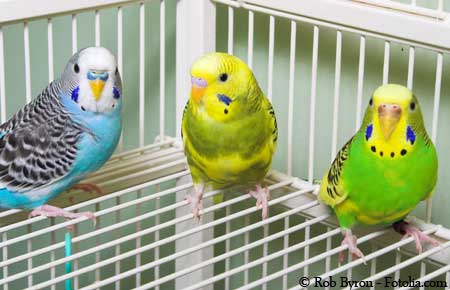Parakeet Cages
No matter how funny it might sound saying this, parakeet cages should be in your houses before you bring the birds home. I have heard of people bringing a new parakeet home, without having a house for him.
When purchasing a cage for your parakeet there are several requirements you need to fulfill.

Parakeet cage size
Your budgie parakeet needs to have a lot of space. Even if you let him spend most of the day in the room, out of his cage, the cage is still his house.
Parakeets like to fly in their cages so you need to make sure there is enough space for that. The height of the cage is not such a big deal because the bird will fly from one side to the other, horizontally.
There are different opinions on the proper size for a parakeet cage. I would say, based on the experience with my birds, that the smallest cage you should get is at least 18 by 14 inches. The height is about 20-24 inches with parakeet cages of this size.
Of course, if you can afford it, you should aim for bigger ones.
To save some money, you might want to shop online for these pet supplies, because they are often cheaper than in pet stores.
In case you are getting a couple of birds, you don't really have to get the cage that is the double in size, but like I mentioned, try to get as big cage as you can afford it.
Shape of the best parakeet cages
Always get a rectangular cage for your parakeet. Rounded ones are out of question here, because parakeets like jumping and ?hiding? in corners.
Bars
Parakeets have small heads, smaller than they look, so they can easily get stuck between the cage bars if there is too much space between them.
I personally always had cages that had about 1cm space between bars (about 0.4 inches).
Cleaning and parakeet cages maintenance
It is very important to get a cage that is easy to clean. If you need to get your hands in the cage to clean it, don't do it. That will scare your bird, especially if he is a newcomer.
Always get the cage that has a detachable bottom or a bottom you can pull out like a little drawer. That way you will not upset the bird when cleaning.
Safe materials
Parakeets love to chew on stuff and the cage will be no different. They need something to chew on to maintain their beak so a bird will try anything, toys, perches, cage bars.
You need to make sure that the material used to make a cage is safe. Stainless steel comes to mind.
Never use old, rusty cages or those that have chips peeling off. Even if you want to repaint it, don't, because that can be toxic for your bird.
Parakeet cages are so cheap these days that your safest choice is to buy a new one.
Where to put the cage
Or better said, where not to put the cage. You don't want to put the cage in the kitchen because of the fumes. Second reason is the danger of the bird falling on a hot stove or into a full sink.
You should never leave the bird and the cage in a drafty spot because that is one of the main reasons for parakeet death or serious illness.
The safest place is a corner of a room that is not too crowded all the time. That way your pet bird will have some peace and quiet but at the same time won't be alone all the time.
What to put in the cage
The standard parakeet cage accessories include:
- water and food bowls
- cuttle bone
- perches
- bird toys
Don't put too many items in the cage and make it crowded because that will make it impossible for the bird to fly in it.
Also, get a big piece of cloth and make a cover for the cage. Cover the cage when it is sleeping time for your bird so it has some peace, quiet and dark.
If you have some really cool cage photos to share with us and show how proud you are of your bird's cage, make sure to send them through the parakeet photos page. I would love to see them.
Related articles
Parakeet
training
How
long do parakeets live
Choosing
a pet bird
Go from
parakeet cages to Cool Small Pets home page
Comments
Have your say about what you just read! Leave me a comment in the box below.